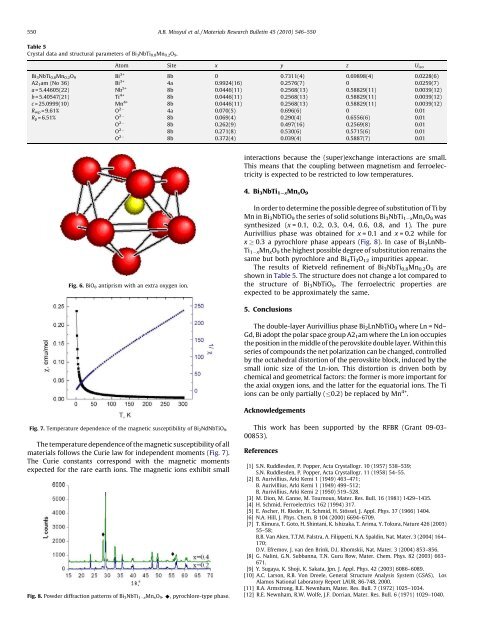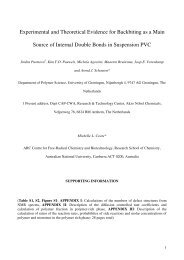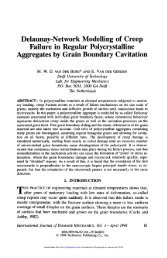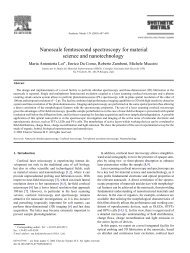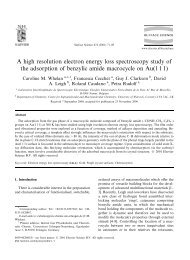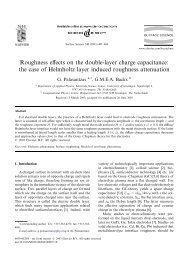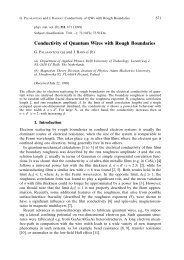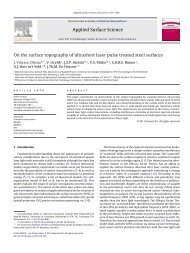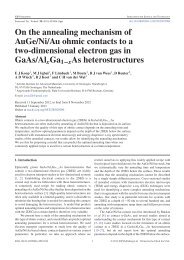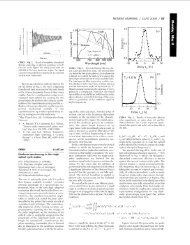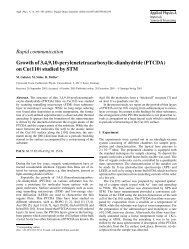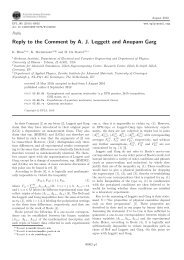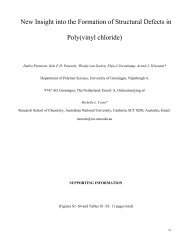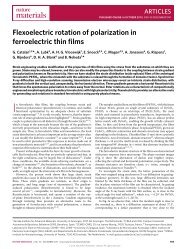Double-layered Aurivillius-type ferroelectrics with magnetic moments
Double-layered Aurivillius-type ferroelectrics with magnetic moments
Double-layered Aurivillius-type ferroelectrics with magnetic moments
You also want an ePaper? Increase the reach of your titles
YUMPU automatically turns print PDFs into web optimized ePapers that Google loves.
550<br />
A.B. Missyul et al. / Materials Research Bulletin 45 (2010) 546–550<br />
Table 5<br />
Crystal data and structural parameters of Bi 3 NbTi 0.8 Mn 0.2 O 9 .<br />
Atom Site x y z U iso<br />
Bi 3 NbTi 0.8 Mn 0.2 O 9 Bi 3+ 8b 0 0.7311(4) 0.69898(4) 0.0228(6)<br />
A2 1 am (No 36) Bi 3+ 4a 0.9924(16) 0.2576(7) 0 0.0259(7)<br />
a = 5.44605(22) Nb 5+ 8b 0.0446(11) 0.2568(13) 0.58829(11) 0.0039(12)<br />
b = 5.40547(21) Ti 4+ 8b 0.0446(11) 0.2568(13) 0.58829(11) 0.0039(12)<br />
c = 25.0999(10) Mn 4+ 8b 0.0446(11) 0.2568(13) 0.58829(11) 0.0039(12)<br />
R wp = 9.61% O 2 4a 0.070(5) 0.696(6) 0 0.01<br />
R p = 6.51% O 2 8b 0.069(4) 0.290(4) 0.6556(6) 0.01<br />
O 2 8b 0.262(9) 0.497(16) 0.2569(8) 0.01<br />
O 2 8b 0.271(8) 0.530(6) 0.5715(6) 0.01<br />
O 2 8b 0.372(4) 0.039(4) 0.5887(7) 0.01<br />
interactions because the (super)exchange interactions are small.<br />
This means that the coupling between magnetism and ferroelectricity<br />
is expected to be restricted to low temperatures.<br />
4. Bi 3 NbTi 1Sx Mn x O 9<br />
Fig. 6. BiO 8 antiprism <strong>with</strong> an extra oxygen ion.<br />
In order to determine the possible degree of substitution of Ti by<br />
Mn in Bi 3 NbTiO 9 the series of solid solutions Bi 3 NbTi 1 x Mn x O 9 was<br />
synthesized (x = 0.1, 0.2, 0.3, 0.4, 0.6, 0.8, and 1). The pure<br />
<strong>Aurivillius</strong> phase was obtained for x = 0.1 and x = 0.2 while for<br />
x 0.3 a pyrochlore phase appears (Fig. 8). In case of Bi 2 LnNb-<br />
Ti 1 x Mn x O 9 the highest possible degree of substitution remains the<br />
same but both pyrochlore and Bi 4 Ti 3 O 12 impurities appear.<br />
The results of Rietveld refinement of Bi 3 NbTi 0.8 Mn 0.2 O 9 are<br />
shown in Table 5. The structure does not change a lot compared to<br />
the structure of Bi 3 NbTiO 9 . The ferroelectric properties are<br />
expected to be approximately the same.<br />
5. Conclusions<br />
The double-layer <strong>Aurivillius</strong> phase Bi 2 LnNbTiO 9 where Ln = Nd–<br />
Gd, Bi adopt the polar space group A2 1 am where the Ln ion occupies<br />
the position in the middle of the perovskite double layer. Within this<br />
series of compounds the net polarization can be changed, controlled<br />
by the octahedral distortion of the perovskite block, induced by the<br />
small ionic size of the Ln-ion. This distortion is driven both by<br />
chemical and geometrical factors: the former is more important for<br />
the axial oxygen ions, and the latter for the equatorial ions. The Ti<br />
ions can be only partially (0.2) be replaced by Mn 4+ .<br />
Acknowledgements<br />
Fig. 7. Temperature dependence of the <strong>magnetic</strong> susceptibility of Bi 2 NdNbTiO 9 .<br />
The temperature dependence of the <strong>magnetic</strong> susceptibility of all<br />
materials follows the Curie law for independent <strong>moments</strong> (Fig. 7).<br />
The Curie constants correspond <strong>with</strong> the <strong>magnetic</strong> <strong>moments</strong><br />
expected for the rare earth ions. The <strong>magnetic</strong> ions exhibit small<br />
Fig. 8. Powder diffraction patterns of Bi 3 NbTi 1 x Mn x O 9 . ^, pyrochlore-<strong>type</strong> phase.<br />
This work has been supported by the RFBR (Grant 09-03-<br />
00853).<br />
References<br />
[1] S.N. Ruddlesden, P. Popper, Acta Crystallogr. 10 (1957) 538–539;<br />
S.N. Ruddlesden, P. Popper, Acta Crystallogr. 11 (1958) 54–55.<br />
[2] B. <strong>Aurivillius</strong>, Arki Kemi 1 (1949) 463–471;<br />
B. <strong>Aurivillius</strong>, Arki Kemi 1 (1949) 499–512;<br />
B. <strong>Aurivillius</strong>, Arki Kemi 2 (1950) 519–528.<br />
[3] M. Dion, M. Ganne, M. Tournoux, Mater. Res. Bull. 16 (1981) 1429–1435.<br />
[4] H. Schmid, Ferroelectrics 162 (1994) 317.<br />
[5] E. Ascher, H. Rieder, H. Schmid, H. Stössel, J. Appl. Phys. 37 (1966) 1404.<br />
[6] N.A. Hill, J. Phys. Chem. B 104 (2000) 6694–6709.<br />
[7] T. Kimura, T. Goto, H. Shintani, K. Ishizaka, T. Arima, Y. Tokura, Nature 426 (2003)<br />
55–58;<br />
B.B. Van Aken, T.T.M. Palstra, A. Filippetti, N.A. Spaldin, Nat. Mater. 3 (2004) 164–<br />
170;<br />
D.V. Efremov, J. van den Brink, D.I. Khomskii, Nat. Mater. 3 (2004) 853–856.<br />
[8] G. Nalini, G.N. Subbanna, T.N. Guru Row, Mater. Chem. Phys. 82 (2003) 663–<br />
671.<br />
[9] Y. Sugaya, K. Shoji, K. Sakata, Jpn. J. Appl. Phys. 42 (2003) 6086–6089.<br />
[10] A.C. Larson, R.B. Von Dreele, General Structure Analysis System (GSAS), Los<br />
Alamos National Laboratory Report LAUR, 86-748, 2000.<br />
[11] R.A. Armstrong, R.E. Newnham, Mater. Res. Bull. 7 (1972) 1025–1034.<br />
[12] R.E. Newnham, R.W. Wolfe, J.F. Dorrian, Mater. Res. Bull. 6 (1971) 1029–1040.


